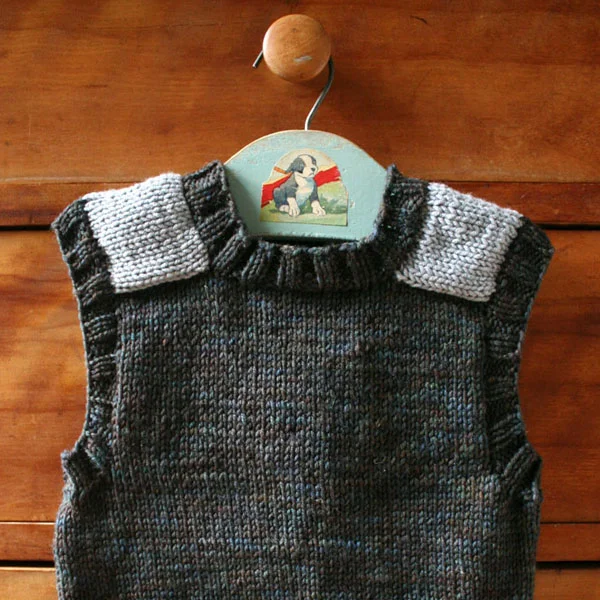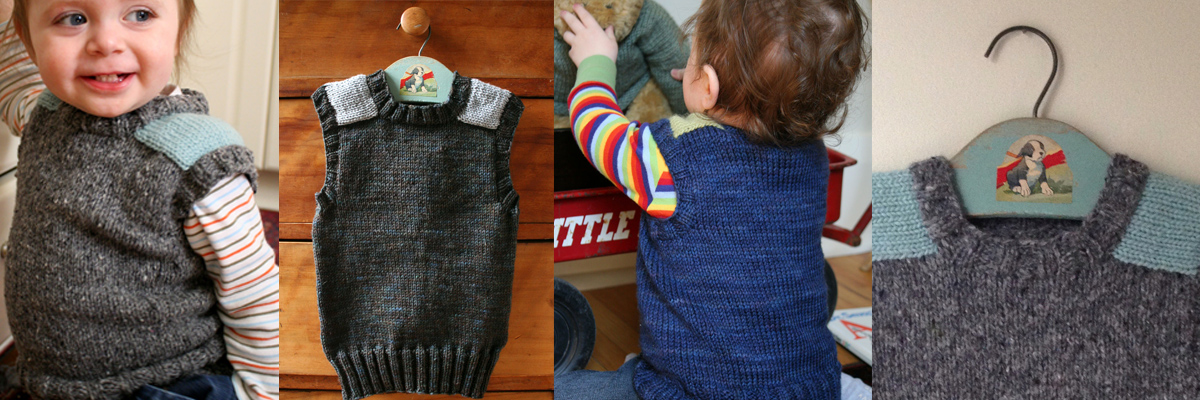Wow, I hardly recognize my little model. It's been almost 6 years since I posted this vest pattern, and my guy just hasn't stopped growing. Of course, the three vests above no longer fit him, but they each got a lot of wear. The dark grey version (which we called his "Han Solo" vest) actually fit Milo until last year. But now he is officially without vests, and that definitely needs to change.
With a few nudges from other vest knitters, and some awesome help from Allie, the Snappy Shoulder Vest pattern is now updated to include 6, 8 and 10 year old sizes. I'm a wee bit blog-challenged these days, so instead of editing the old post, I'm simply adding the updated pattern below (the old post will include a link to get you here). Someday I hope to make PDFs of my older, free patterns, but hopefully this works for now. I'm itching to get started on a new vest for Milo, and I hope you enjoy knitting up some larger vests too!
You will need:
• Main Colour (MC): 350 (400, 475, 550, 650) yds/ 320 (365, 435, 500, 595) m worsted weight wool
• Contrast Colour (CC): 20 yds/18 m worsted to aran weight wool for shoulders (this is a great use for scrap wool!)
• US7/4.5mm needles (16” circ)
• extra US 7/4.5mm needle (for holding stitches)
• US6/4mm needles (DPNs)
• 1 stitch marker
Gauge: 19 stitches x 26 rows in stockinette = 4”/10cm square
Sizes: 2T (4T, 6, 8, 10)
Finished dimensions: 21¾ (23½, 26, 28, 29.5)” chest circumference, 14½” (16, 18.5, 21, 22)” garment length (or longer – the body is up to you!)
SHOULDER SADDLES (make 2)
Using CC, CO 20 (20, 22, 26, 28) sts. Knit in stockinette for 14 (14, 16, 18, 20) rows and bind off on RS row.
FRONT
Using main wool, pick up 12 (12, 13, 16, 18) stitches along vertical edge of a shoulder saddle. CO 15 (17, 19, 21, 23), then pick up 12 (12, 13, 16, 18) stitches along vertical edge of the second shoulder saddle (39 [41, 45, 53, 59] stitches on needle). Turn work and purl to end. Turn work and knit to end. Continue knitting flat in stockinette for 3” (3.5, 4, 4.5, 4.75)” ending on a WS row. Next row (RS): Knit to end, CO2. Next row (WS): Purl to end, CO2. Next row (RS): Knit across 43 (45, 49, 57, 63) stitches and transfer to spare 4.5mm needle.
BACK
This time, it’s much easier to see where you are picking up stitches, because the shoulder saddles are already in place. So, using your main wool, pick up 12 (12, 13, 16, 18) stitches along remaining vertical edge of a shoulder saddle. CO 15 (17, 19, 21, 23) then pick up 12 (12, 13, 16, 18) stitches along vertical edge of the second shoulder saddle (39 [41, 45, 53, 59] stitches on needle). Turn work and purl to end. Turn work and knit to end. Continue knitting flat in stockinette for 4” (4.5, 5.5, 5.5, 5.75)” ending on a WS row. Next row (RS): Knit to end, CO2. Next row (WS): Purl to end, CO2. Turn work. Now you’re ready to join in the round.
BODY
Knit across 43 (45, 49, 57, 63) stitches, CO 9 (11, 13, 9, 9), knit across the FRONT 43 (45, 49, 57, 63) stitches from your spare needle, and CO 9 (11, 13, 9, 9). You should have 104 (112, 124, 132, 144) stitches in total. Join in the round and sit back for some relaxing, mindless knitting. The body length is truly up to you – I knit in stockinette for 6 (7, 8.75, 10.5, 11)”.
BOTTOM
[K2, P2] ribbing for 2.5” and bind off loosely.
NECKBAND
You can easily tell the front of the vest because the neckline is lower. Using 4mm DPNs and your main wool, pick up 17 (21, 23, 25, 27) stitches across the back neckline of the vest, 17 (17, 19, 23, 25) across one saddle, 17 (21, 23, 25, 27) across the front neckline, and another 17 (17, 19, 23, 25) across the remaining saddle (68 [76, 84, 96, 104] stitches total). PM and [K2, P2] for 5 rows. Bind off loosely.
LEFT ARMHOLE
Using 4mm DPNs and your main wool, determine the bottom center of the armhole and pick up 18 (21, 25, 27, 29) stitches from this point until you reach the shoulder saddle. Pick up 17 (17, 19, 23, 25) stitches across saddle, then 21 (26, 30, 32, 32) stitches along the back (56 [64, 74, 82, 86] stitches total). PM and [K2, P2] for 5 rows. Bind off loosely.
RIGHT ARMHOLE
Using 4mm DPNs and your main wool, determine the bottom center of the armhole and pick up 21 (26, 30, 32, 32) stitches from this point until you reach the shoulder saddle. Pick up 17 (17, 19, 23, 25) stitches across saddle, then 18 (21, 25, 27, 29) stitches down the front (56 [64, 74, 82, 86] stitches total). PM and [K2, P2] for 5 rows. Bind off loosely.
Weave in all ends and block if desired. Find your favourite little person and keep them toasty warm in their newest vest!
















